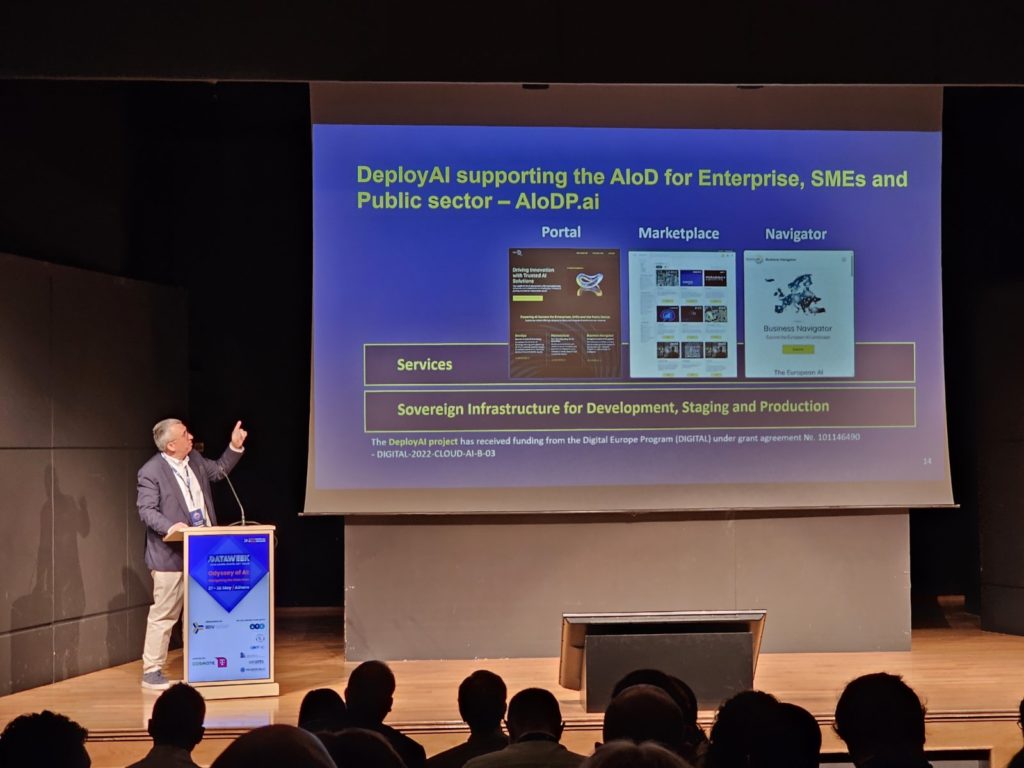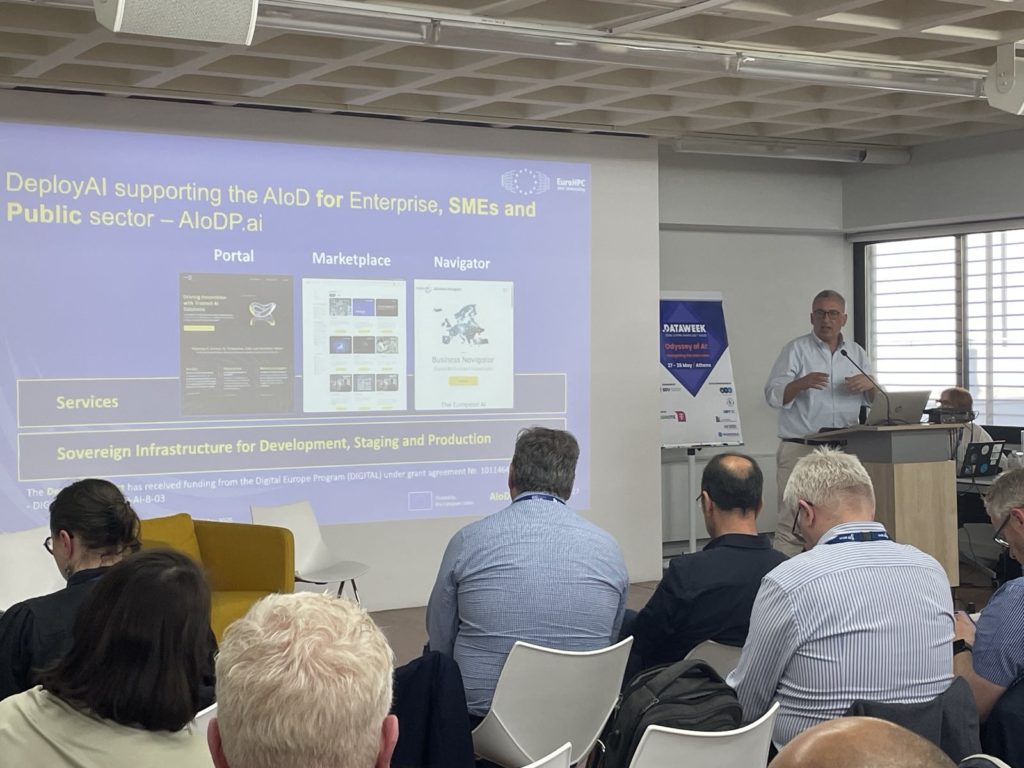
Reflections from the plenary and workshop discussions in Athens on Europe’s path toward integrated, trusted AI development.
Last week, I had the opportunity to participate in Data Week 2025, the spring gathering of Europe’s Big Data and Data-Driven AI community, hosted this year in Athens by BDVA – Big Data Value Association and OTE Group of Companies (HTO). Held under the theme “Odyssey of AI: Navigating the Data Seas,” the event focused on how artificial intelligence can unlock the value of data across sectors, and how coordinated infrastructure is essential to achieving this goal.
In the opening plenary session, I delivered a talk on how European AI initiatives—from European Digital Innovation Hubs and the AI-on-Demand Platform to AI Factories and AI Giga Factories – can be better coordinated to accelerate innovation and avoid fragmentation. All these initiatives are pillars of the European Commission’s AI Action Plan, which aims to scale the development, adoption, and trust in AI technologies across the Union.
Later, in a focused workshop on AI platforms and data interoperability, I presented the work we are co-leading at NCSR “DEMOKRITOS” through DeployAI, a sovereign infrastructure developed under the DIGITAL EUROPE Programme.
These two sessions, one strategic, one technical, highlighted the growing complexity of Europe’s AI ecosystem, but also the opportunities for deeper alignment. The four insights that follow are drawn from both discussions and reflect the steps I believe are essential if we are to move from parallel efforts to integrated action.

Over the past five years, the European Commission has launched a robust suite of flagship initiatives: the AI-on-Demand Platform (AIoDP), the European Digital Innovation Hubs Network (EDIHs), the AI Factories, and most recently, the AI Giga Factories. These are designed to accelerate the development and deployment of trustworthy AI, while supporting digital transformation across public and private sectors. They represent complementary efforts under the AI Action Plan—bringing together data, infrastructure, talent, and computing power into scalable innovation pipelines.
By combining the discovery and experimentation capacity of the AI-on-Demand Platform with the EDIHs and the applied deployment infrastructure of the Factories, Europe can enable AI development that is both research-driven and market-ready. Connecting these platforms meaningfully is essential to support faster transitions from concept to real-world application.
At the same time, Common European Data Spaces are being established to provide secure, sovereign access to EU-level data repositories—including sources such as Copernicus—as well as national and proprietary datasets. These data spaces are secure, structured frameworks designed to enable the interoperable and lawful sharing of data across borders and industries, while maintaining full control by data holders.
These data spaces are not only essential to ensuring access to high-quality training data for AI systems—they also offer a legal and governance model that allows organizations to collaborate on data without relinquishing ownership or control. This opens new opportunities for innovation, particularly in sensitive domains such as health, mobility, energy, and the environment.
Yet alongside these investments, there was a shared recognition at Data Week of the risk that such initiatives could evolve in parallel without sufficient coordination. Europe’s infrastructure for AI and data is substantial, but its full value will only be realised if these components are connected, interoperable, and aligned under a shared vision. The next step is integration.

2. Realising the promise of Data Spaces requires deeper platform integration
One area where this need for alignment is especially urgent is in the development of Common European Data Spaces, which aim to provide trusted, legally sound access to data in areas such as health, mobility, environment, and energy.
From the perspective of AI development, platforms like AIoDP must be able to connect with Common European Data Spaces, so that AI systems can be trained and deployed using high-quality, trusted, and legally accessible data. This requires technical compatibility, aligned governance frameworks, and common standards for access and licensing. Otherwise, valuable datasets will remain inaccessible or underused.
Integration efforts should include standardized metadata models, licensing frameworks, and strong interoperability mechanisms. More importantly, these technical bridges need to be supported by clear governance models and aligned investment strategies. To avoid silos and build trust in cross-border data flows, national repositories, research institutions, and platform developers will need to work together in a coordinated and transparent way.
At NCSR Demokritos, we are co-leading the development of the AI-on-Demand Platform (AIoDP) through the DeployAI project, a sovereign infrastructure funded by the Digital Europe Programme. The platform provides an environment for the design, training, deployment, and scaling of trustworthy AI applications, tailored to enterprises, SMEs, and the public sector.
AIoDP allows users to access HPC and cloud resources, experiment with European Large Language Models, work with sector-specific datasets and tools, and publish services in a secure and compliant framework.
One key feature of AIoDP is the Business Navigator, an interactive interface that maps the European AI landscape, helping users identify collaborators and opportunities. This reflects our commitment not only to developing infrastructure but also to ensuring it can be navigated, connected, and applied in real-world contexts.

4. Greece continues to play an active role in Europe’s AI ecosystem
Greece’s contribution to the European AI landscape has grown significantly. The country is now home to seven operational EDIHs, addressing sectors such as energy, health, agri-food, and public administration.
At NCSR Demokritos, we have played a leading role in establishing two of these hubs and continue to collaborate actively with all of them, ensuring that innovations developed locally can scale at the European level. Initiatives like DeployAI demonstrate how national excellence can support shared European objectives—not only in terms of infrastructure, but also in shaping ethical, human-centric deployment of AI technologies.
Toward a more connected and innovation-driven AI infrastructure for Europe
Europe has made the right strategic investments. But ensuring they generate real value for innovation, industry, research, and society will require better alignment, deeper integration, and shared operational frameworks.
At Data Week 2025, it became clear that this is not simply a technical task—it is a collective responsibility across public and private actors, member states, and platforms. Projects like DeployAI offer one path forward: connecting tools with people, infrastructures with institutions, and innovation with impact.
Thank you to Dr. Eva Karatairi for additional research and reporting on this article